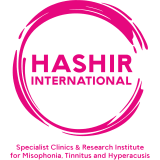This informal CPD article How the use of British Society of Audiology recommended procedures for audiometry and measurement can lead to discomfort for patients with tinnitus and/or hyperacusis was provided by Dr. Hashir Aazh at Rehabilitation and Therapy Skills Development, a Therapy Specialist Clinic offering Rehabilitation Programmes for Management of Tinnitus, Hyperacusis and Misophonia.
Patients seeking treatment for tinnitus and hyperacusis
Patients seeking treatment for tinnitus and hyperacusis are usually assessed via personal interviews with a trained audiologist, by asking them to complete a variety of standardised questionnaires, by conducting pure-tone audiometry (PTA), and via the measurement of uncomfortable loudness levels (ULLs).
Pure-Tone Audiometry (PTA)
PTA provides a measure of the weakest sounds that can be detected for tones with different frequencies. In contrast, ULLs provide a measure of the sound intensity above which tones with different frequencies become uncomfortably loud. Both are measured in units called “decibels hearing level” (dB HL), where 0 dB HL is the weakest sound that can be detected by young people with no known hearing problem.
For normal-hearing people without hyperacusis, the average ULL across the audiometric frequencies is about 100 dB HL (Sherlock & Formby 2005). However, for a person with hyperacusis, the across-frequency average ULL is usually 77 dB HL or below (Aazh & Moore 2017a). In extreme cases of hyperacusis, ULLs can be as low as 10 dB HL (Aazh & Moore 2017c).
Such low ULLs raise the possibility that some patients will experience discomfort during routine audiometry and measurement of ULLs. The proportion of patients for whom this might happen was assessed in a recent study by Aazh and Moore (2017b). The study was based on 362 consecutive patients who attended a National Health Service audiology clinic for tinnitus and/or hyperacusis rehabilitation.
PTA was conducted using the procedure recommended by the British Society of Audiology (BSA) (2011a) for frequencies of 0.25, 0.5, 1, 2, 3, 4, 6, and 8 kHz. According to this procedure, once the threshold has been determined at a given frequency, the initial level when assessing the threshold for the next frequency should be “at a clearly audible level (e.g. 30 dB above the adjacent threshold” (p. 11), but never more than 80 dB HL. An experience of discomfort during PTA was deemed to be present when a test tone with a given frequency presented at 30 dB above the threshold for an adjacent frequency exceeded the ULL at the test frequency for at least one of the measured frequencies.
Remarkably, the results showed that discomfort would have occurred for 21% of the patients. The incidence of discomfort would have been reduced to 10%, 2.7%, and 0.8% if the starting level had been 20 dB above, 10 dB above, or at the same level as the threshold for the adjacent frequency, respectively.
ULLs were also measured using the BSA recommended procedure (British Society of Audiology 2011b). According to this, the audiologist should “Start testing at 60 dB HL or at the subject’s hearing threshold level for that ear at that frequency, whichever is highest, unless otherwise indicated (Section 2.2)” (p.7).
Discomfort during measurement of ULLs
An experience of discomfort during measurement of ULLs was deemed to be present if the starting level of 60 dB HL exceeded a patient’s ULL for at least at one of the measured frequencies. Discomfort would have occurred for 24% of the patients using this criterion. The incidence of discomfort would have been reduced to 3.6% if the starting level had been reduced to 30 dB HL and to 0.5% if the starting level had been reduced to 15 dB HL.
Given the high prevalence of anxiety and stress in patients seeking help for tinnitus and hyperacusis, it is very important to ensure that any evaluation procedures do not lead to any unnecessary discomfort. If discomfort is experienced, this might trigger further anxiety and stress, leading to worsening of the symptoms and to possible loss of trust in the audiologist. This in turn might reduce the effectiveness of any therapy performed by the audiologist after the initial evaluation.
To avoid discomfort during PTA, Aazh and Moore (2017b) suggested using an initial level of 0 dB HL at the starting frequency of 1 kHz and setting the level for subsequent frequencies to be equal to the level at threshold for the previously tested frequency. To avoid discomfort during measurement of ULLs, they recommended that the starting level for a given test frequency should be equal to the measured audiometric threshold at that test frequency and that levels above 80 dB HL should not be used.
We hope this article was helpful. For more information from Rehabilitation and Therapy Skills Development, please visit their CPD Member Directory page. Alternatively please visit the CPD Industry Hubs for more CPD articles, courses and events relevant to your Continuing Professional Development requirements.
References
Aazh, H., & Moore, B. C. J. (2017a). Factors related to Uncomfortable Loudness Levels for patients seen in a tinnitus and hyperacusis clinic. International Journal of Audiology, (in press).
Aazh, H., & Moore, B. C. J. (2017b). Incidence of discomfort during pure-tone audiometry and measurement of uncomfortable loudness levels among people seeking help for tinnitus and/or hyperacusis. American Journal of Audiology, (in press).
Aazh, H., & Moore, B. C. J. (2017c). Prevalence and characteristics of patients with severe hyperacusis among patients seen in a tinnitus and hyperacusis clinic. Journal of the American Academy of Audiology, (in press).
British Society of Audiology (2011a). Pure-tone air-conduction and bone-conduction threshold audiometry with and without masking: Recommended procedure. Reading, UK: British Society of Audiology.
British Society of Audiology (2011b). Recommended procedure: Determination of uncomfortable loudness levels. Reading, UK: British Society of Audiology.
Sherlock, L. P., & Formby, C. (2005). Estimates of loudness, loudness discomfort, and the auditory dynamic range: normative estimates, comparison of procedures, and test-retest reliability. Journal of the American Academy of Audiology, 16, 85-100.













